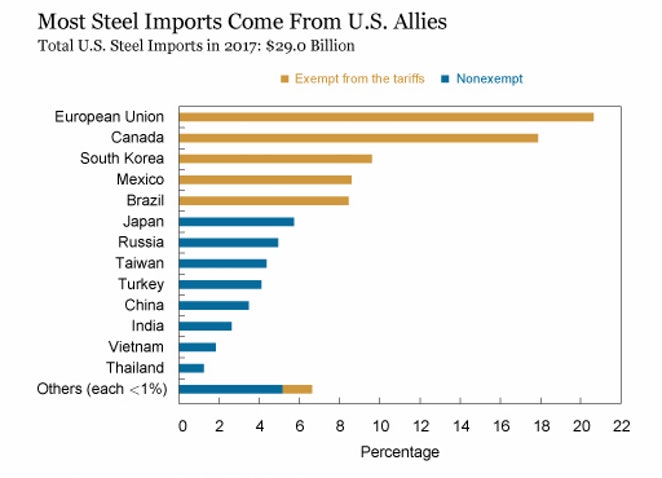Fed economists admits the obvious “Tariffs likely to kill jobs”.
On occasion, Fed economists get things correct even if the voting members get things backward.
For example, New York Fed economists ask and answer the question: Will New Steel Tariffs Protect U.S. Jobs?
Consider this a guest post courtesy of New York Fed researchers Mary Amiti, Sebastian Heise, and Noah Kwicklis. As such I will dispense with blockquotes.
Will New Steel Tariffs Protect U.S. Jobs?
Although the tariffs were introduced under a national security argument, most U.S. imports are actually sourced from U.S. allies. The chart below shows that the largest supplier of steel to the United States is the European Union, accounting for more than 20 percent of its total steel imports.
Countries for which the tariff is currently not applied account for 67 percent of U.S. steel imports, although this figure may change as negotiations with the currently exempt countries proceed. What is striking about this chart is the very small share, only 3.5 percent, originating from China. One reason for these trade patterns is that a large portion of imported steel, particularly from China, is already covered by special tariffs.
![]()

As the next chart shows, employment in the steel industry has been on a downward trend for decades. The industry, narrowly defined to only include workers where the steel tariffs apply, just employs 140,000 workers in total. In addition to import competition, rapid technological progress such as the introduction of mini mills has been blamed for displacing workers.
As the chart shows, steel output has been fairly stable over the long run, and so output per worker has been on the rise. Since 2000, employment in steel production fell 33 percent while output per worker increased 43 percent (an average of more than 2 percent a year).
![]()

How do steel tariffs come into the picture? A tariff increases the price of imported steel, and it enables domestic steel producers to also increase their price. Research on markup adjustments more generally shows that a 10 percent increase in competitor prices leads to a 5 percent increase in domestic prices.
With a 25 percent tax on imported steel, local steel producers can increase their markups and prices, and still stay competitive relative to foreign-produced inputs. This is the so-called protection that tariffs confer.
However, firms that are dependent on steel and aluminum inputs—both importers and non-importers—will face higher prices. Downstream domestic producers will have to increase their prices or reduce markups, which makes them uncompetitive relative to competing imports.
Similarly, U.S. exporters that need steel or steel-related inputs will face higher input costs and will have to either increase export prices or reduce their profit margins. These effects could lead to lower employment in these steel-intensive industries and possibly plant shut downs.
Researchers estimate that the number of jobs in steel-intensive industries, which they define as industries with steel inputs of at least 5 percent of total, is around 2 million—for example, manufacturers of auto parts, motorcycles, and household appliances.
It is in steel-related industries where jobs are likely to be at risk. To get a sense of the magnitude of the employment effects, we can turn to a similar episode in 2002 when President Bush introduced steel tariffs of up to 30 percent, although under different legislation.

